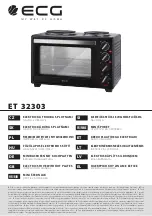
INSTRUCTIONS FOR THE INSTALLER
10
2.
•
The pipes must always have an
upward slant to facilitate movement by
air density.
•
On routes with a lot of load loss (a
lot of retention), air movement can be
forced along the ducts using a motor or
fan, provided that it is designed to
withstand such temperature conditions.
Bear in mind that air ducts mean that
noise travels more easily from one room to
another.
The following table shows the heat
output of the air from the hot-air outlets
with the appliance working at Nominal
Heat Output:
Output
Itaca 80
(kW)
Output
Itaca 100
(kW)
Output
Itaca 120
(kW)
A
1.5
1.5
1.8
B
1.5
1.5
1.8
C
2.7
3.2
3.5
D
2.7
3.2
3.5
Figure No.8 -
Table showing heat output of the
air leaving the appliance
Note:
The values shown in the above
table were measured at the appliance
output point and based on tests performed
at nominal heat output and maximum fan
speed.
All hot-air ducts lose heat, meaning that
the heat output obtained at the end of
piping always depends on its design.
2.3.8.
Piping air to the firebox
On this model, it is possible to pipe air
to the appliance for combustion straight
from outdoors. We recommend that, if
possible, air be drawn from outdoors for
combustion via a non-closable pipe with a
diameter of 120mm leading to the nozzle
on the bottom-front of the appliance. This
is the best option because it means that
draughts are not created in and oxygen is
not consumed from the room in which the
appliance is fitted. A further advantage is
that there is no danger of downdraught
which may hinder the correct updraught of
the appliance when an extractor or
mechanical ventilation appliance is used in
the same room as the central-heating
appliance or in another one alongside it.
If this is not possible, ensure that the
appliance receives air for combustion via
the relevant grille at the bottom of the
hood (in addition to the hood ventilation
grilles).
2.3.8.1.
Combustion-air intake and hot-air
output installation options
Different installation systems need to
be borne in mind depending on the source
of combustion air (air from outdoors or
from inside the room in which the
appliance is fitted) and the hot-air output
system (air output by natural convection or
by forced convection involving a fan) to
ensure that ITACA-INCA appliances work
properly. There now follows a description
and image of each of these options:
Summary of Contents for ITACA Series
Page 1: ...Itaca 80 100 120 C V Instruction Book...
Page 32: ...BASIC BREAKDOWNS 31 6...
Page 33: ...BASIC BREAKDOWNS 32 6...
Page 34: ...BASIC BREAKDOWNS 33 6...
Page 35: ...DECLARATION OF PERFORMANCE 34 7 DECLARATION OF PERFORMANCE...
Page 36: ...DECLARATION OF PERFORMANCE 35 7...
Page 37: ...DECLARATION OF PERFORMANCE 36 7...
Page 38: ...DECLARATION OF PERFORMANCE 37 7...
Page 39: ...DECLARATION OF PERFORMANCE 38 7...
Page 40: ...DECLARATION OF PERFORMANCE 39 7...
Page 41: ...CE MARK 40 8 CE MARK...
Page 42: ...CE MARK 41 8...
Page 43: ...CE MARK 42 8...












































